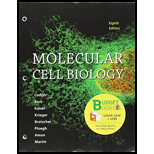
Concept explainers
To Review:
The three components of the eukaryotic cytoskeletal filaments. Compare them in terms of the composition, function and structure.
Introduction:
The cytoskeleton is the interlinking protein filament, which is present in the cytoskeleton of the eukaryotic as well as prokaryotes. It helps in the maintenance of the cellular structure and locomotion.
Explanation of Solution
The eukaryotic cells have three main types of the cytoskeleton filaments. These are microfilaments, intermediate filaments and microtubules.
The microfilaments are also known as the actin filaments and present in the cytoplasm of the eukaryotic cells. They are mainly composed of the
The intermediate filaments are the cytoskeleton structural components which are found in a twisted strand. They are composed of keratin, vimentins and other keratin like subunits. They are 8-12 nm in diameter. The main function of the intermediate filament is to provide mechanical support to the plasma membrane.
The microtubules are the hollow cylindrical filaments, which are made up of a and β-tubulins. They are 24 nm in diameter. The function of the microtubule is to provide shape and internal organization of the cells; it also helps in the division of the cell and movement.
There are three component of the cytoskeleton in the eukaryotic cells.
- Microfilaments: mainly composed of G actin subunit and help in providing structural support and movement.
- Intermediate filaments: mainly composed of keratin and vimetins, they provide mechanical strength.
- Microtubules: mainly help in mobility and cell division. They are made up of a and β-tubulins.
Want to see more full solutions like this?
Chapter 17 Solutions
Loose-Leaf Version for Molecular Cell Biology & LaunchPad for Molecular Cell Biology (6 month access)
 Human Anatomy & Physiology (11th Edition)BiologyISBN:9780134580999Author:Elaine N. Marieb, Katja N. HoehnPublisher:PEARSON
Human Anatomy & Physiology (11th Edition)BiologyISBN:9780134580999Author:Elaine N. Marieb, Katja N. HoehnPublisher:PEARSON Biology 2eBiologyISBN:9781947172517Author:Matthew Douglas, Jung Choi, Mary Ann ClarkPublisher:OpenStax
Biology 2eBiologyISBN:9781947172517Author:Matthew Douglas, Jung Choi, Mary Ann ClarkPublisher:OpenStax Anatomy & PhysiologyBiologyISBN:9781259398629Author:McKinley, Michael P., O'loughlin, Valerie Dean, Bidle, Theresa StouterPublisher:Mcgraw Hill Education,
Anatomy & PhysiologyBiologyISBN:9781259398629Author:McKinley, Michael P., O'loughlin, Valerie Dean, Bidle, Theresa StouterPublisher:Mcgraw Hill Education, Molecular Biology of the Cell (Sixth Edition)BiologyISBN:9780815344322Author:Bruce Alberts, Alexander D. Johnson, Julian Lewis, David Morgan, Martin Raff, Keith Roberts, Peter WalterPublisher:W. W. Norton & Company
Molecular Biology of the Cell (Sixth Edition)BiologyISBN:9780815344322Author:Bruce Alberts, Alexander D. Johnson, Julian Lewis, David Morgan, Martin Raff, Keith Roberts, Peter WalterPublisher:W. W. Norton & Company Laboratory Manual For Human Anatomy & PhysiologyBiologyISBN:9781260159363Author:Martin, Terry R., Prentice-craver, CynthiaPublisher:McGraw-Hill Publishing Co.
Laboratory Manual For Human Anatomy & PhysiologyBiologyISBN:9781260159363Author:Martin, Terry R., Prentice-craver, CynthiaPublisher:McGraw-Hill Publishing Co. Inquiry Into Life (16th Edition)BiologyISBN:9781260231700Author:Sylvia S. Mader, Michael WindelspechtPublisher:McGraw Hill Education
Inquiry Into Life (16th Edition)BiologyISBN:9781260231700Author:Sylvia S. Mader, Michael WindelspechtPublisher:McGraw Hill Education





